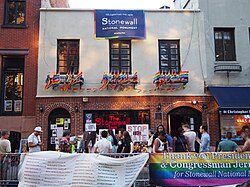
| Part of a series on |
| LGBTQ people |
|---|
| |
The following outline offers an overview and guide to topics about LGBTQ people.
Contents
- Sexuality
- Sexual orientation types
- Topics
- By region
- By culture
- Identities
- Sexual identity topics
- Gender identity topics
- Sex and physiology
- Romance
- Expression
- Practices
- Society
- Homosexuality
- Adoption, parenting, and same-sex marriage
- Same-sex marriage (SSM) by region
- Same-sex partnerships, and immigration
- People topics
- Themes
- Language
- Culture
- By country
- By city
- LGBTQ media
- History
- By country 2
- Timelines
- Religion
- Rights
- By major region
- By area
- Ideology
- Bibliography
- Lists
- Lists of LGBTQ fictional characters
- Anti-LGBTQ topics
- Other topics
- See also
- References
The initialism LGBTQ stands for "lesbian, gay, bisexual, transgender, and queer". [4] It may refer to anyone who is non-heterosexual, non-heteroromantic, and/or non-cisgender, instead of exclusively to people who are lesbian, gay, bisexual, or transgender.